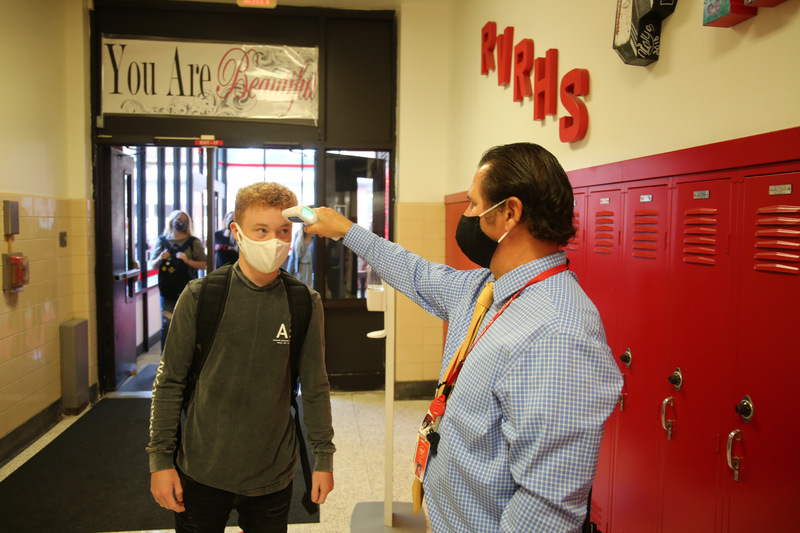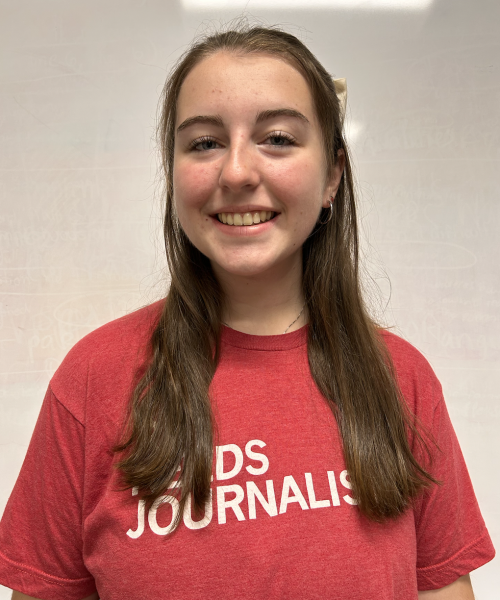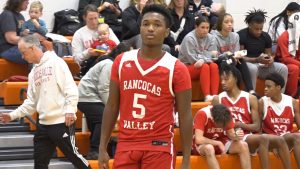Hallowed halls and video calls: the consequences of the drop in attendance
How the falling number of in-person students is affecting the RV community
Photo courtesy of Mr. Maniglia
Mr. Bowker takes student temperatures as they arrive in the morning.
February 8, 2021
Heavy silence slices through the abandoned halls of RV through the early morning chill. Over the past few months, in-person attendance among students has begun rapidly dropping. Classrooms once full of students now only hold small handfuls. The impact this drop has had on our students, teachers, staff, administrators and our entire RV community is one that’s hard to ignore.
“If you took a look, on September 28th I had about four hundred students one day, three hundred-eighty the next day, three hundred-twenty, and then about three hundred,” said Principal Joseph Martin last month. “I was seeing a good amount, and then it started dwindling. When you started seeing the rise in numbers and some positive cases going up, parents were like, ‘I love RV, but I’m going to hold off.’ We tried our best to really respect that, but we really want to do in-person instruction at the same time. There are safety concerns and we’re not blind to them, but I would say the numbers dwindled.”
According to the United States Census, 93% of families with school-age students have children learning on some kind of digital platform. Factoring in the unpredictable number of COVID-19 cases around the nation, plus the implementation of 10 to 14-day quarantines when crossing state borders, there are plenty of valid reasons students and their families are deciding to opt for virtual schooling.
“Obviously, the pandemic affects a lot of families differently,” said Assistant Principal Anthony Bowker. “A lot of people are being exposed, and they have to quarantine for what was then 14, now 10 days. With the school getting shut down and holidays…[and] with different families traveling and different members of families being sick…with all the quarantining going on, we expected it… not being a teacher and being an administrator, I’m in the hallways constantly, and I do the morning ‘meet and greets’ with a thermometer. But you could definitely tell when we first started we had a lot more kids coming in, and then since the [holiday] break, I’m at the main door, there’s probably about fifty-ish kids coming through and there should be three hundred coming through the door. I’m just excited to get kids back in with a little more consistency as well; I think it’s good.”
The excitement to bring back students resonates through teachers as well, as the new cohorts will pull in larger classes and allow teachers to take steps closer to educational normalcy.
“I think it’s great from an educational standpoint,” said choir director Grant Mech about the new cohorts. “There were days where I would have one person in a class; those are my really small groups. Voices is a medium-sized group, and we’ve had anywhere from three to five [students]. In Concert Choir, on the very first day of hybrid learning, we had 19 people in a section and we had to be on stage. Then after that day, it was never that big again. So I want to say Concert Choir lately has been averaging between five, and maybe once in a while, there’s 10. Concert Choir has 55 people enrolled in it, so out of 55, there [are] only five in the room. You know, that’s less than 10%.”
There’s no doubt that extracurricular activities have been affected by the pandemic and the current learning environment, especially music programs around the nation. Concerts weren’t feasible this semester, leaving Mech and the members of RV’s music department out to find creative ways to showcase student’s success and growth. The extra hours put in by these educators do not go unnoticed, and hopefully someday soon we’ll all be able to enjoy the sounds of RV’s music groups together again.
However, the struggles never end in terms of educating, as now there is a call for balance between the in-person and virtual groups. How does one find that middle ground?
“For me as a teacher, because we’re going to have more people in the room two days a week, I’ll plan differently,” said Mech. “I’ll target our virtual-only day differently than I will for in-person. I think for me, the thing I’m most worried about is balancing in-person, like who’s in the room, versus who’s on the screen, for those two hybrid days. I want to make sure that everybody is getting what they need and that they’re engaged and they feel like they’re connected to the people who are in the room. It’s just a tough balance; you want to make sure that people feel like they’re in one class. I think choir helps with that.”
“I understood why there was a drop in student in-person attendance,” said history teacher Jennifer White. “When more [COVID-19] cases happen, it is natural to want to protect yourself and loved ones. It made more sense to keep my lesson plans the same whether in-person or virtual, because I only had one to three students in class. First semester, the most amount I was supposed to have were eight students, but again, that dwindled down to four on any given day. Some days, I had only one or two students. As far as the new cohorts go, I am excited to see more students. In one block, I will be seeing nine students daily. For Social Studies, we can do more in-class activities when there are more students and I feel that we can make that ‘personal connection’ we all miss. However, as the pandemic continues I feel that we all need to be cautious now that we have more entering the building.”
As the new cohorts strengthen in numbers, the question running through the heads of many members of our RV community is if we’re still keeping safe. According to Principal Martin, the safety of staff and students is always front and center and still remains a top priority.
“We worked with Mrs. Esola, our school nurse; she’s our chief liaison to the Burlington County Health Department,” said Martin. “We talk to them about the numbers of our school, the size of our classrooms, how many kids we can have in a classroom, and what we should do in terms of distancing and masking. We also did a survey and ran the numbers. So Dr. Heilig, me and some other members of the leadership team, we took all those numbers, and then we made our best informed, data-driven decision… So that’s what made the decision, the data made the decision.”
This goal of a more consistent daily attendance is one that resonates strong with the administration. RV’s new attendance policy strives to ensure more responsibility among the student population while also keeping in-person attendance up so teachers have the opportunity to help students thrive in the current educational environment.
“We’re going to take attendance a little more seriously,” said Bowker. “If you start missing your cohorts, we’re going to ask you to go full remote so that we can have more students in the building. It’s okay if you choose remote, but you’re going to be remote, you can’t have the best of both worlds. We’d like to have that but we just can’t have it… When teachers are thinking they’re supposed to have eight kids in a class and they go in and there’s one, it makes the dynamics of the classroom very hard to teach. Plus, it messes with your psyche a little bit when you have a lesson planned and no one’s there to be in-person. Class sizes are looking really good with the red and white numbers. I’m excited to have kids in the building. I haven’t had kids in the building since March, and I’ve been here every single day, so it’s exciting to see kids.”
Amid the staff who are greatly affected by this drop in attendance are the students. Showing up to an almost empty classroom and only interacting with rectangles or icons on a screen is extremely disheartening.
“The most people that I have in my in-person classes are three,” said junior Noah Castellani. “I feel like I am learning a lot less and I have to teach myself the lessons for the most part. Having less interaction with peers and teachers has definitely affected my education… I’ve learned a lot less than I usually would. It will definitely affect my future education because I wasn’t able to learn everything I need to, therefore in my next classes I will be behind some other kids who were able to learn everything that they had to.”
Each grade is set to their own disadvantages during this time, but those set back the most are arguably the freshmen. Learning the inner workings of a new school while also navigating it blindly is rough, especially when you know nothing about the people around you. This setback could be a part of the deterrence from attending school in-person for freshmen and new students.
“I’m really nervous about the freshmen,” Bowker said. “They’re coming into a big school and really have never walked around or experienced what we had to offer. They missed the freshman orientation and getting to meet those teachers and build those relationships. Learning what high school is rather than coming out of that eighth grade environment where it’s loud and obnoxious; you’re more mature when you get to high school. Now we’re at the beginning of February, and for a lot of them it’s going to be their first time coming into a high school environment, so I’m a little nervous about that.”
Freshman Krysten Wilson is looking forward to the new cohorts of the second semester. “There used to be about five to seven kids in the class but now it’s just one to two,” she said. “It’s been harder to keep an organized schedule and nothing has really been consistent. I joined a few clubs but lost interest because there is no interaction. Being face to face with a teacher is a lot easier when it comes to learning new material. That goes with my peers too. Most people hide behind cameras when we go to breakout rooms, and it’s quiet. If we were in-person it would be much easier.”
The new cohorts and the new semester bring an overwhelming amount of positivity to our current education situation. With more students entering the building, there is new hope for normalcy. And while no one knows exactly what the future holds, we do know that we are never alone. Schools around the world are currently facing the same dilemmas we are in terms of questioning the safety of our staff and students. Everyday things are changing for the better, as cases are slowly leveling off and vaccinations are continuing to be administered. Some day soon we’ll all be able to learn together again, but until then, it may be an uphill battle.
“I don’t know if we’ll ever get to five days this current school year,” said Principal Martin. “But technically, that should be our goal; to try to be in school every day. Yet, no one’s got that magic crystal ball.”








Roger Budd • Feb 12, 2021 at 10:11 am
Thoughtful and meaningful article about our RV community. Keep up the good work.